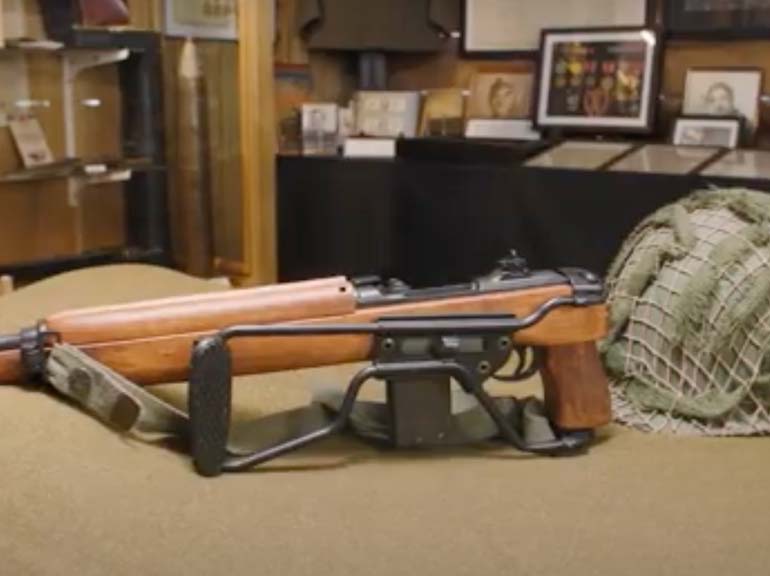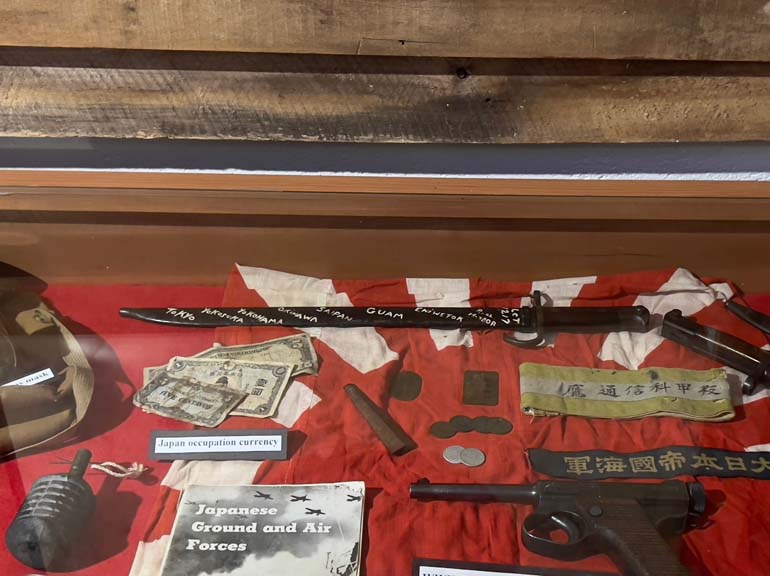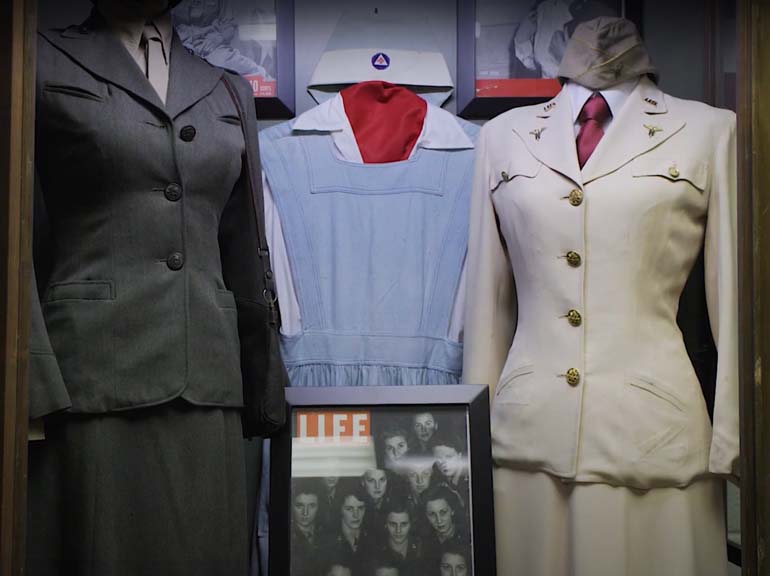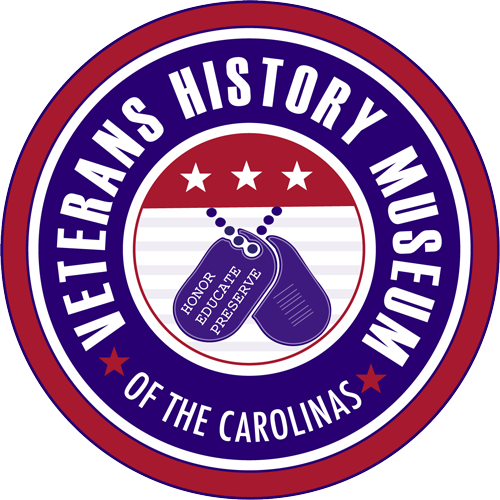WWII Exhibit
The WWII exhibit is divided into two sections – the European Theater of Operations (ETO) and the Pacific Theater of Operations (PTO). The ETO exhibit has a soldier realistically outfitted in period Army uniform and equipment while the PTO has a Marine similarly outfitted. Actual newspapers from the period announce the surrender or the end of the War. There are many unique and unusual US, German and Japanese artifacts on display, each with its own story.

WWII M1 A1 Carbine

WWII Pacific Artifacts

WWII Women’s Uniforms
WWII European Theater
Fascism
This new word struck fear into the heart of Europe and led to WWII a war that became the largest and deadliest armed conflict in the history of humankind.
In 1917, President Wilson had urged America to join world war I to make the world “safe for democracy.” Instead, in just two decades, the brutalizing effects of the war and the punitive measures of the Treaty of Versailles gave rise to an unprecedented threat to freedom. The Treaty humiliated Germany while failing to resolve the underlying issues that had led to war in the first place.
Fascism arose first in Italy as a movement which saw democracy as a failure and nationalism, political violence, and an all-powerful state as the path to cultural rejuvenation. In Germany, the Nazi party seduced a nation in economic distress and humiliated by defeat with dreams of domination and the persecution and elimination of all but the Aryan “master race.” Fascist leaders Adolph Hitler and Benito Mussolini, both veterans of World War I, dreamed of empires built on the ruins of the liberal west and the communist east. In 1939, their dreams became the world’s nightmare.
German troops invaded Poland
On September 1, German troops invaded Poland, triggering the United Kingdom and France to declare war on Germany. In the next two years, six more countries, including France, fell to Hitler’s armies, while the UK suffered the relentless bombing known as The Blitz.
United States enters the war in December 7, 1941
In the United States, the public’s memories of the tragic losses of World War I limited President Roosevelt’s ability to offer the Allies anything beyond weapons and supplies. But the country was finally thrust into the war on December 7, 1941, when Germany’s ally Japan attacked the American Navy at Pearl Harbor.
By 1942 World War II encircled the globe, forcing nearly every country on earth to align with one of two massive military alliances: the Axis powers, led by Germany, Italy, and Japan; or the Allies, led by Great Britain, the United States, the Soviet Union, France, and China.
Hitler’s Buzzsaw
Technological advances since the last war meant combatants faced weapons of unprecedented power. On the ground, Nazi Germany’s fearsome M-42 machine gun fired a blistering 1200 rounds per minute, earning it the nickname “Hitler’s Buzzsaw”.
In the air, the German Luftwaffe entered the conflict with the best wartime aircraft in the world, the Messerschmitt BG 109. But by 1944, the North American Aviation P-51 mustang, an American long-range fighter-bomber, helped ensure Allied air superiority.
While the First World War sent combatants into the air, in the second, they rained from the sky. The M1A1 Carbine was designed specifically for paratroopers. The rifle weighed only five pounds and, with the stock folded, measured just 25 inches, enabling paratroopers to jump, land, and run.
WASPS – Women Airforce Service Pilots
And there weren’t only men in the air. The Women Airforce Service Pilots or as they were called – WASPS – ferried 77 types of aircraft, encountering dangerous flying conditions and suffering flight-related injuries. According to Allied Commander Eisenhower, the war effort could not have been won without the women in uniform.
The war in Europe neared its conclusion with the allied invasion of Germany. American soldiers marked their victories by lowering Nazi flags and replacing them with Old Glory. One of the final combat missions was the capture the “Eagle’s Nest”, the Nazis’ Mountain Chalet where Hitler had entertained heads of state. Triumphant American soldiers celebrated, drank his wine, and gathered souvenirs, including bricks and fabric from the sofas.
Germany surrenders on May 8, 1945
The fighting finally concluded with the fall of Berlin, Hitler’s suicide, and Germany’s surrender on May 8, 1945. The Allied victory was made possible by untold numbers of heroic acts, honored by the American military with decorations such as the Silver Star, Bronze Star, Air Medal and the Purple Heart.
Joining the heroes who fought on the front lines were Americans from all walks of life whose effort and sacrifice on the home front were essential to the victory over fascism.
But the war in the Pacific raged on. As Winston Churchill warned in his VE Day announcement: “We may allow ourselves a brief period of rejoicing but let us not forget for a moment the toil and efforts that lie ahead.”
WWII Pacific Theater
FMidway. Guadalcanal. Okinawa. Iwo Jima.
On these tiny patches of land in the vast Pacific Ocean, American servicemen braved rough seas and dangerous landings only to encounter intense heat, rampant disease, and an unfamiliar terrain while in ferocious combat against a determined Japanese enemy. In the Pacific theater, amphibious warfare came into its own.
December 7, 1941 Japan attacks Pearl Harbor
On December 7, 1941, the Imperial Japanese Navy launched a surprise air attack on Pearl Harbor, severely damaging the US Pacific Fleet. Within hours of the attack on Pearl Harbor, Japanese forces also invaded the Philippines, seizing US airfields and naval facilities.
For the next six months, the Japanese controlled the Pacific, occupying numerous strategic islands over thousands of square miles, including the Philippines, where US and Filipino forces fought a determined defense for over five months. Without reinforcement or resupply, they finally surrendered at Bataan.
Many Japanese warriors carried Good Luck Flags inside their shirts. Adorned with messages from loved ones wishing them victory and safety, the flags reminded soldiers of their unfailing duty to their country.
Battle of Midway considered the turning point of the war in the Pacific
The decisive Battle of Midway in June 1942 is considered the turning point of the war in the Pacific. The Japanese navy was now no longer capable of major offensive campaigns, allowing the Allies to start their own Pacific offensive.
Two weapons gave American troops a strategic advantage throughout the war. The M1919A, the Marine Corps’ primary light machine gun, delivered unsurpassed ease of operation, reliability, and firepower. The semi-automatic M1 Garand was America’s standard-issue rifle. General George Patton called the Garand “the greatest battle implement ever devised” because it enabled what Patton called “marching fire” – rapid, accurate fire while advancing on foot.
US mounted its first major amphibious landing on the island of Guadalcanal
In August 1942, the US mounted its first major amphibious landing on the island of Guadalcanal. The ferocious fight for control of the island and its critical airfield continued for more than six months. American troops lived in misery enduring dense jungle terrain, heat, oppressive humidity, mosquitoes, and malaria. Constant nighttime bombardment from a foe determined to kill as many enemies as possible without surrender resulted in enormous losses on both sides.
A major step toward victory at Guadalcanal was the Battle of Edson’s Ridge, named after Lieutenant Colonel Merrit A. Edson, leader of the legendary Marine Corps Raiders . Specialists in speed, surprise, and guerilla tactics, the 800 Raiders at Edson’s Ridge, defending the island’s strategic airfield, held off 2,500 Japanese fighters in vicious close-quarter combat.
In October 1944, US forces returned to the Philippines. Landing at Leyte Gulf they joined with the Filipino Army and guerrilla units and defeated Japanese forces throughout the Philippines.
Kamikaze attacks
Desperate to reverse the growing Allied advantage, the Japanese employed suicide bombers. The terrifying sight of Japanese pilots diving their planes into ships became a constant fear to American soldiers and sailors. To thwart these kamikaze attacks, battleship personnel practiced anti-aircraft gunnery using newly created target kites. Towed from the stern of the ship, the kites could loop, dive, climb, and make figure-eights.
America invades Okinawa
America’s invasion of Okinawa in April of 1945, just 350 miles from Japan, proved to be the bloodiest and largest amphibious assault in the Pacific theater. It marked the final major conflict of World War II. Victory in Europe was celebrated on May 8 and by the end of June the Allies were closing in on the Japanese home islands.
Despite horrific losses on Iwo Jima and Okinawa, it was clear the Japanese would never surrender in their fight to save their homeland. Military experts projected a land invasion of Japan could cost the lives of up to a million U.S. soldiers and many more Japanese.
August 1945, atomic bombs were dropped on Hiroshima and Nagasaki
The capacity to end the war was in President Truman’s hands, but it required unleashing the most brutal weapon ever created. In August 1945, atomic bombs were dropped on Hiroshima and Nagasaki, annihilating both cities and killing more than 200,000 citizens. On September 2, 1945, General Douglas MacArthur accepted Japan’s formal surrender aboard the USS Missouri.
The Second World War was now over. More than 400,000 Americans—and an estimated 65 million people worldwide—died in the war. At a terrible cost to the Japanese civilian population, the atomic bomb brought an end to the horrific fighting — and signaled the dawn of the nuclear age.
After experiencing war through these videos, we feel grief, respect, admiration, and gratefulness for those who gave all, for those who came through so changed (or damaged), and for those who loved and love them. The best we can do is to listen to their stories. To try to see through their eyes and understand what they sacrificed. This is how we honor their courage and love of our country.
